Stuffed (5)
By:
March 28, 2015
One in a new series of posts by Tom Nealon, author of the highly popular 2010–2012 HiLobrow series DE CONDIMENTIS. The posts in the STUFFED series are inspired by Nealon’s collection of rare cookbooks, which he sells — among other things — via Pazzo Books. His rare cookbook catalog is available here as a PDF or a full color book (which makes a great stocking stuffer).
STUFFED SERIES: THE MAGAZINE OF TASTE | AUGURIES AND PIGNOSTICATIONS | THE CATSUP WAR | CAVEAT CONDIMENTOR | CURRIE CONDIMENTO | POTATO CHIPS AND DEMOCRACY | PIE SHAPES | WHEY AND WHEY NOT | PINK LEMONADE | EUREKA! MICROWAVES | CULINARY ILLUSIONS | AD SALSA PER ASPERA | THE WAR ON MOLE | ALMONDS: NO JOY | GARNISHED | REVUE DES MENUS | REVUE DES MENUS (DEUX) | WORCESTERSHIRE SAUCE | THE THICKENING | TRUMPED | CHILES EN MOVIMIENTO | THE GREAT EATER OF KENT | GETTING MEDIEVAL WITH CHEF WATSON | KETCHUP & DIJON | TRY THE SCROD | MOCK VENISON | THE ROMANCE OF BUTCHERY | I CAN HAZ YOUR TACOS | STUFFED TURKEY | BREAKING GINGERBREAD | WHO ATE WHO? | LAYING IT ON THICK | MAYO MIXTURES | MUSICAL TASTE | ELECTRIFIED BREADCRUMBS | DANCE DANCE REVOLUTION | THE ISLAND OF LOST CONDIMENTS | FLASH THE HASH | BRUNSWICK STEW: B.S. | FLASH THE HASH, pt. 2 | THE ARK OF THE CONDIMENT | SQUEEZED OUT | SOUP v. SANDWICH | UNNATURAL SELECTION | HI YO, COLLOIDAL SILVER | PROTEIN IN MOTION | GOOD RIDDANCE TO RESTAURANTS.
Give a man a bottle of ketchup and the whole world begins to look like a french fry. — Benjamin Disraeli
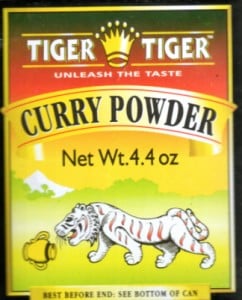
Much like barbecue sauce, there is no such thing as curry powder.
As originally constituted (turmeric, fenugreek, coriander, etc.), “curry powder” represented a general name given to a preliminary understanding of spices used in a few sorts of Indian cookery. There are almost no pre-prepared spice mixes in Indian cuisine; instead, spices are toasted and ground, then used. The idea for curry powder was brought back to England (just as the idea from ketchup was imported from China) and popularized starting in the mid 18th century. But the foundation for curry powder was laid much earlier.
The first mention of curry, according to the OED (though, of course, what they are calling “curry” existed for a few thousand years before the English showed up) is in Iohn Huighen van Linschoten, His discours of voyages into ye Easte [and] West Indies: deuided into foure bookes, published in London by John Wolfe in 1598. Here, curry is described as a sour preparation put on rice (with fish). As late as 1757, travel literature said “currees are infinitely various, being a sort of fricacees, to eat with rice.” Infinitely various!
Whether or not you would precisely call curry a condiment here — it has many of the elements of a good condiment, including variety, user control, and the ability to add it afterwards in order to make food more interesting — it was clearly a big, mutable, wild thing, not what the English would have conceived of as a “dish.” Also worth noting: curry as we know it was a different thing back then, since chile was essentially unknown outside of the Americas until the 17th century.
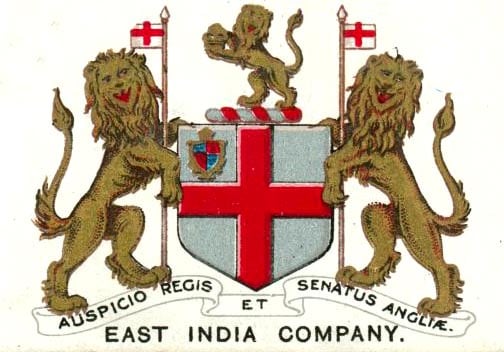
In 1600, two years after Iohn Huighen van Linschoten, His discours of voyages into ye Easte [and] West Indies, the Honourable East India Company was formed to pursue trade in the East Indies under a charter from Queen Elizabeth. Imagine! Julius Caesar was playing at the Globe, Hamlet was on deck and Kit Marlow had just returned from counterfeiting money in the Netherlands (working for the crown to disrupt, among other things, the formation of the Dutch East India Company). Elizabeth’s power was unquestioned, but wars dragged on in Ireland and Spain, and it was becoming increasingly difficult to finance them. She needed something to rekindle the optimism and grandeur of her reign’s earlier years, and something to pay the endless bills. So the first of Europe’s East India Companies was formed, just nipping the formation of the Dutch one.
The Honourable East India Company started small, with subscriptions (218 subscribers underwrote the start of the company), and traded in cotton, silk, spices, saltpetre, indigo — i.e., mostly low-hanging fruit. Struggles for territory caused some early tensions (e.g., the group of ten company men who were executed on Ambon by the Dutch East India company for conspiring with the Japanese to steal the clove trade; battles in India with the Portuguese), but eventually the British consolidated their position in India. As the Honourable East India Company grew larger, raised armies, and administered territory, their need to grow, to feed the beast so that it could grow (and grow hungrier), increased.
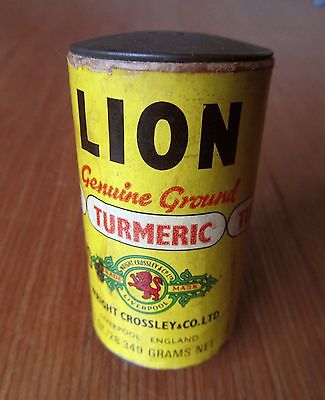
As the Company outgrew the initial markets it had been formed to exploit, it turned its slathering maw to secondary spices like turmeric. With widespread use in medicine and cookery all through Indian culture, and equally widely available, turmeric was a likely candidate for trade. However, though known and used in Europe since the late middle ages as a cheaper substitute for saffron (it was used as a coloring, not a flavoring), there was little immediate need or profitability for the quantities available in India. What was needed was demand back in Britain for all of this turmeric supply. After a few false starts (tooth powder, fox repellent, and who can forget turmeric-ade? Turmeric-ade, turmeric-ade, there’s noth-ing better for man or maid!) a turmeric-based powder for seasoning rice dishes was settled on.
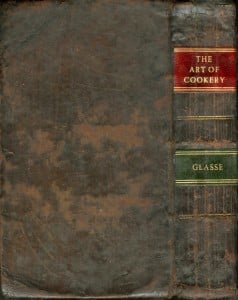
The initial introduction of curry to Britain was subtle, as stoking a non-existent demand must ever be. Returning nabobs brought with them talk and a taste for the cuisine of the land that made them rich. The first cookbook recipe appeared in Hannah Glasse’s Art of Cookery Made Plain and Easy in 1747. Glasse’s cookbook was enormously popular, the most popular and influential of the 18th century, and getting a curry/turmeric recipe in there ended up being a major coup. Soon other cookbooks followed suit and curry was established. In a turn of events that it would be irresponsible to portray as coincidental, Hannah Glasse’s oldest son, Isaac, landed a choice position as a writer for the East India Company and sailed for Bombay a few years later.
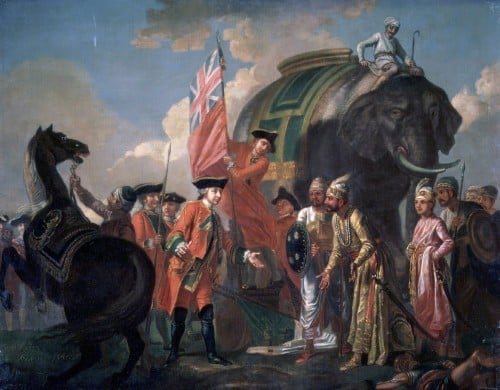
Ten years later, in 1757, and just a year after the French attack on Minorca signaled the start of the Seven Years’ War, Robert Clive and British forces defeated the army of the last independent Nawab of Bengal, Nawab Siraj-ud-daulah (who was being aided by elements of the French East India company) at the Battle of Plassey.
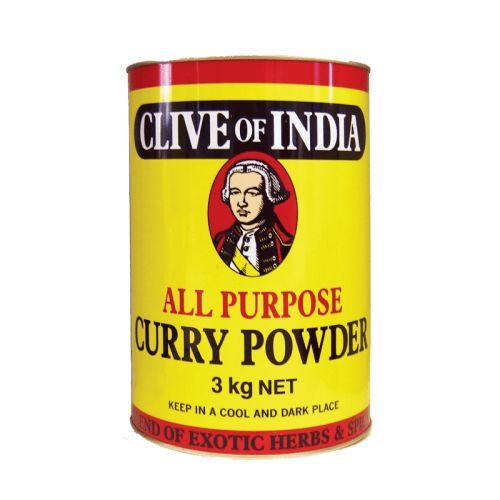
Clive lives on in his eponymous curry powder. As the popularity of curry grew and took on a life of its own, nabobs enriched by their time with the company in India opened the the Hindostanee Coffee House (1809) and the Oriental Club (1824) in London to serve curry and other Indian dishes and cultivate a demand for turmeric-laden curry powder.
By 1773, as a result of the costs of repeated military “interventions” in India, the East India Company found itself in genuinely difficult financial straits. Two plans emerged to try and remedy this situation: first, they would eliminate the middleman and sell tea directly to the American consumer (with just a small tax paid to the crown) and they would pull the trigger on their turmeric strategy selling “curry powder” directly to British consumers. Regrettably, while their second scheme took hold, their first resulted in the American Revolution.
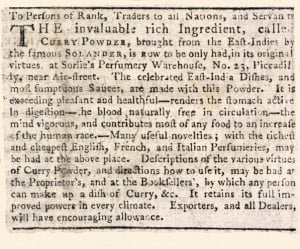
Back in fair Albion this set off a spirited and ill-tempered battle for curry powder and paste supremacy. At one point Captain White, the ultimate victor, referred to a rival powder as Shah Soojah’s Ashes — and spread fear and alarm about the dangers of counterfeit powders and potentially pirated pastes. The Captain’s products, it was claimed, were not only unusually delicious and genuine, they were restorative to the health (which, ironically, given the medicinal properties of turmeric, was probably true).
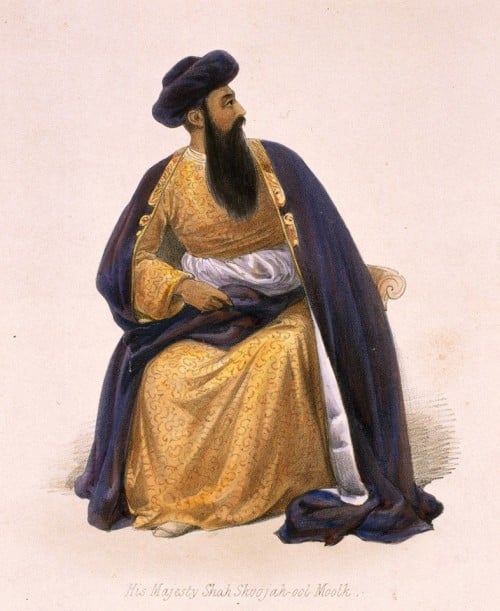
Captain White’s curry paste was recommended by no less an authority on everything kitchen related than Alexis Soyer and used by the head chef of The Oriental Club, the most popular and hallowed hang for returning British East India company men. Around this time, we start to see curry powder replace the individual ingredients in cookbooks — no more turmeric, fenugreek, coriander, chile, etc., mixed up together. Just “curry powder.”
Following Plassey, the Honourable East India Company ruled India for 100 years, until the 1857 Indian Rebellion forced the British Crown to assume direct rule of India and dismantle the Company, assuming control of their three armies. In 1849, Dr. Riddell (also author of, Britishly enough, A Manual for Gardening in Western India) published his Indian Domestic Economy.
First published in Bombay, Indian Domestic Economy was reprinted in Madras a few years later, and eventually in London. It’s actually a nice cookbook, with some nuance as it describes the various regional cuisines. It also describes the picturesque and appropriate scene of locals using purloined British gravestones to grind spices — a nice parting image for the long reign of the Honourable East India Company.
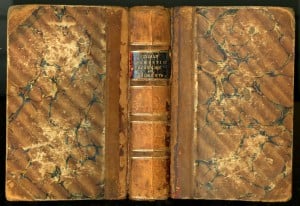
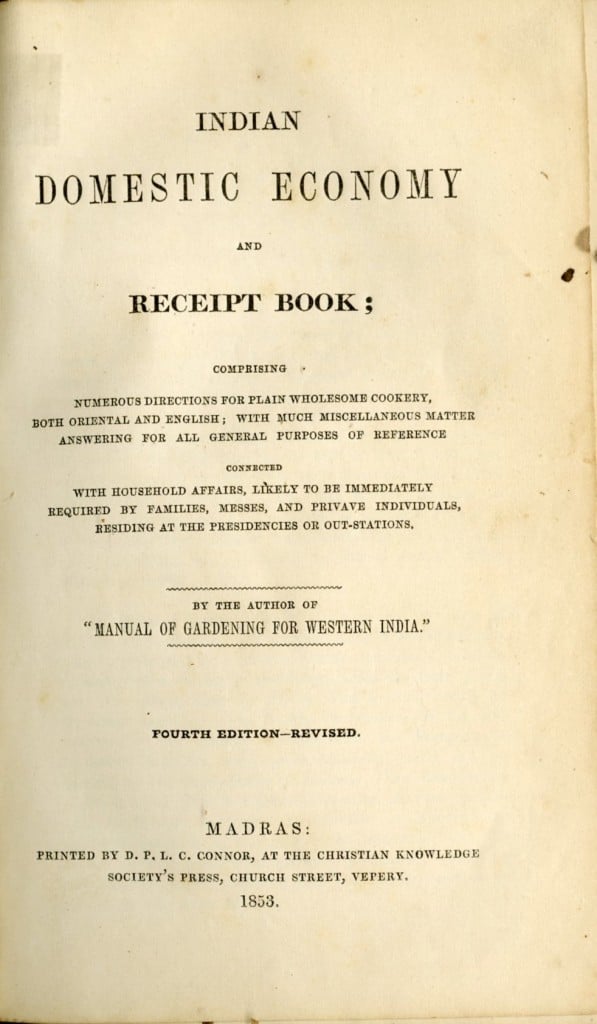
I can appreciate the clever hegemony of Anglo-Indian cuisine and the co-opting of wild flavors and spices to turn into a product, but — you know — I’m American. I would prefer to see the job finished. Curry was a wild, various thing until it was subdued, dumbed down, domesticated for the Empire. Fine, but why not go all the way! Turn it back into a condiment at least — let me grab a bottle of vindaloo to shake onto my rice, my burrito, my turkey sandwich. Let me spread some sweet, sweet tikka masala on my garden burger, my hot dog. Let me shake some biryani-flavored butter on my popcorn.
PS: In fairness, the British have given us this syncretic monstrosity.
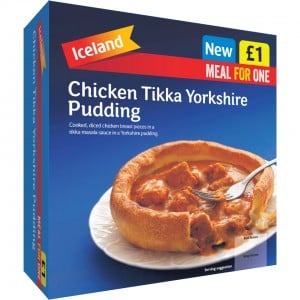
STUFFED SERIES: THE MAGAZINE OF TASTE | AUGURIES AND PIGNOSTICATIONS | THE CATSUP WAR | CAVEAT CONDIMENTOR | CURRIE CONDIMENTO | POTATO CHIPS AND DEMOCRACY | PIE SHAPES | WHEY AND WHEY NOT | PINK LEMONADE | EUREKA! MICROWAVES | CULINARY ILLUSIONS | AD SALSA PER ASPERA | THE WAR ON MOLE | ALMONDS: NO JOY | GARNISHED | REVUE DES MENUS | REVUE DES MENUS (DEUX) | WORCESTERSHIRE SAUCE | THE THICKENING | TRUMPED | CHILES EN MOVIMIENTO | THE GREAT EATER OF KENT | GETTING MEDIEVAL WITH CHEF WATSON | KETCHUP & DIJON | TRY THE SCROD | MOCK VENISON | THE ROMANCE OF BUTCHERY | I CAN HAZ YOUR TACOS | STUFFED TURKEY | BREAKING GINGERBREAD | WHO ATE WHO? | LAYING IT ON THICK | MAYO MIXTURES | MUSICAL TASTE | ELECTRIFIED BREADCRUMBS | DANCE DANCE REVOLUTION | THE ISLAND OF LOST CONDIMENTS | FLASH THE HASH | BRUNSWICK STEW: B.S. | FLASH THE HASH, pt. 2 | THE ARK OF THE CONDIMENT | SQUEEZED OUT | SOUP v. SANDWICH | UNNATURAL SELECTION | HI YO, COLLOIDAL SILVER | PROTEIN IN MOTION | GOOD RIDDANCE TO RESTAURANTS.
MORE POSTS BY TOM NEALON: Salsa Mahonesa and the Seven Years War, Golden Apples, Crimson Stew, Diagram of Condiments vs. Sauces, etc., and his De Condimentis series (Fish Sauce | Hot Sauce | Vinegar | Drunken Vinegar | Balsamic Vinegar | Food History | Barbecue Sauce | Butter | Mustard | Sour Cream | Maple Syrup | Salad Dressing | Gravy) — are among the most popular we’ve ever published here at HILOBROW.
